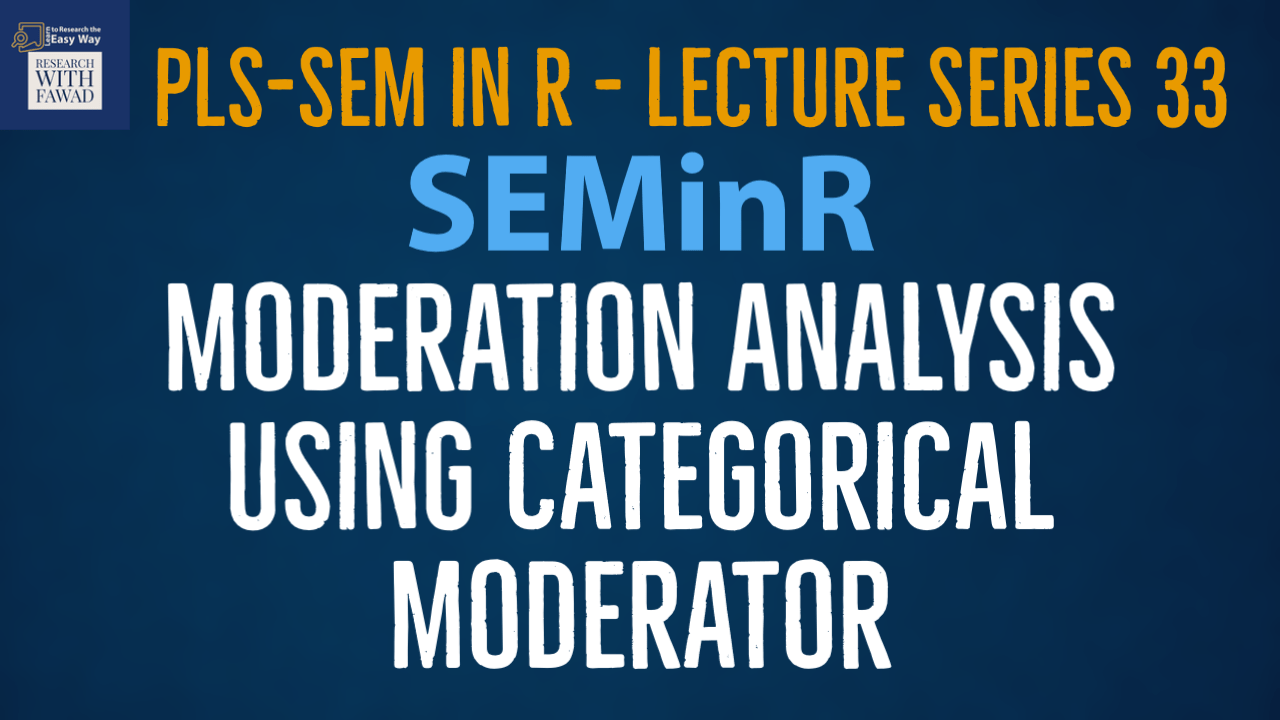How to Analyze Categorical Moderator in SEMinR?

How to Analyze Categorical Moderator in SEMinR?
For Complete Step by Step SEMinR Tutorial Playlist, Click Here
Moderation Analysis with Categorical Moderator using SEMinR?
How to Design and Analyze a Measurement Model in SmartPLS 4?
library(seminr)
# Load the Data
datas <- read.csv(file = "Data.csv", header = TRUE, sep = ",")
head(datas)
# Create measurement model
simple_mm <- constructs(
composite("OC", multi_items("OC", 1:8)),
composite("POS", multi_items("POS", 1:5)),
composite("CC", multi_items("CC", 1:6)),
composite("Private", single_item("Type")),
interaction_term(iv = "OC", moderator = "Private", method = two_stage),
interaction_term(iv = "POS", moderator = "Private", method = two_stage))
# Create structural model
simple_sm <- relationships(
paths(from = c("OC", "POS"), to = "CC"),
paths(from = c("Private"), to = "CC"),
paths(from = c("OC*Private"), to = "CC"),
paths(from = c("POS*Private"), to = "CC"))
simple_pls <- estimate_pls(
data = datas,
measurement_model = simple_mm,
structural_model = simple_sm,
missing = mean_replacement,
missing_value = "-99")
summary_simple <- summary(simple_pls)
plot(simple_pls)
# Bootstrap the model on the PLS Estimated Model
boot_model <- bootstrap_model(
seminr_model = simple_pls,
nboot = 1000,
cores = parallel::detectCores(),
seed = 123)
# Store the summary of the bootstrapped model
# alpha sets the specified level for significance, i.e. 0.05
summary_boot <- summary(boot_model, alpha = 0.05)
# Inspect the bootstrapped structural paths
summary_boot$bootstrapped_pathsCategorical Moderator SEMinR
H1: Type of Bank Moderates the Relationship between Organizational Commitment and Organizational Culture such that Private Sector Banks have a stronger impact of Organizational Commitment on Organizational Culture.
H2: Type of Bank Moderates the Relationship between Perceived Organizational Support and Organizational Culture such that Private Sector Banks have a stronger impact of Perceived Organizational Support on Organizational Culture.
Steps in Interpreting Categorical Moderation Analysis in SEMinR
- In order to clearly identify how the interaction differs in terms of the groups, including the size and precise nature of the effect, we shall draw an interaction plot.
- Review the Steepness of the Line.
- The group where steepness is higher, the impact if stronger.
- Download Link
Sample Interpretation
For H1: Type of Bank Moderates the Relationship between Organizational Commitment and Organizational Culture such that Private Sector Banks have a stronger impact of Organizational Commitment on Organizational Culture.
The results revealed a significant moderating role of Type of Bank on the relationship between OC and Collaborative Culture. The plot shows a steeper and positive gradient for private sector banks as compared to public sector banks. Thus, this shows that the impact of OC in fostering collaborative culture is stronger in private banks as compared to public sector banks. Hence, H1 is supported.
H2: Type of Bank Moderates the Relationship between Perceived Organizational Support and Organizational Culture such that Private Sector Banks have a stronger impact of Perceived Organizational Support on Organizational Culture.
The results revealed a significant moderating role of Type of Bank on the relationship between POS and Collaborative Culture. The plot shows a steeper and positive gradient for public sector banks as compared to private sector banks. Thus, this shows that the impact of POS in fostering collaborative culture is stronger in public sector banks as compared to private sector banks. Hence, H2 is not supported.
Video
Reference
License (http://creativecommons.org/licenses/by/4.0/)
Additional SEMinR Tutorials
- An Introduction to R and R Studio
- An Introduction to SEMinR Package
- Create Project, Load, and Inspect the Data
- SEMinR Package: An Introduction to Evaluating Formative Measurement Model
- SEMinR Package: Analyzing Categorical Predictor Variables
- SEMinR Package: Bootstrapping PLS Model
- SEMinR Package: Evaluating Formative Measurement Model – Convergent Validity and Collinearity
- SEMinR Package: Evaluating Formative Measurement Model – Step 3- Indicator Weights
- SEMinR Package: Evaluating Formative Measurement Model – When to Delete Formative Indicators
- SEMinR Package: Evaluating Reflective Measurement Model
- SEMinR Package: Evaluating Structural Model
- SEMinR Package: Evaluating Structural Model – Step 4: Predictive Power (PLSPredict)
- SEMinR Package: Higher Order Analysis – REF-FOR
- SEMinR Package: Higher Order Analysis – REF-REF
- SEMinR Package: How to Solve Convergent and Discriminant Validity Problems
- SEMinR Package: Mediation Analysis
- SEMinR Package: Moderation Analysis
- SEMinR Package: PLS Estimation
- SEMinR Package: Print, Export and Plot Results
- SEMinR Package: Reflective Measurement Model Step 2: Consistency and Step 3: Convergent Validity
- SEMinR Package: Reflective Measurement Model Step 4: Discriminant Validity
- SEMinR Package: Single Item, SmartPLS Comparison and Summary of SEMinR
- SEMinR Package: Specifying Measurement Model
- SEMinR Package: Specifying the Structural Model